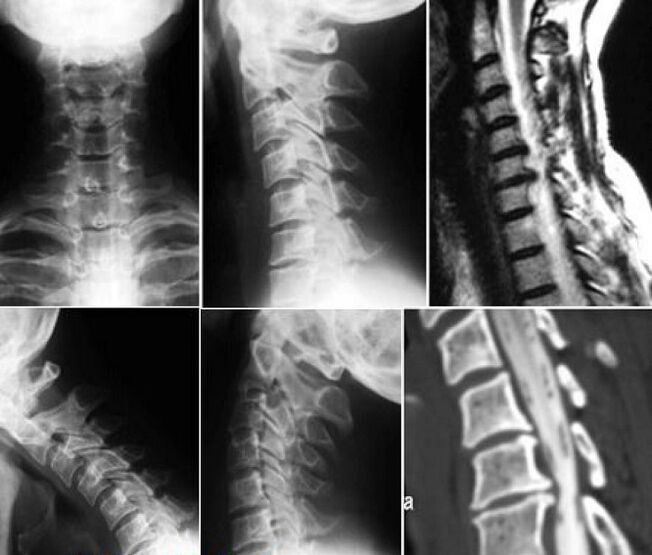Cervical osteochondrosis is typical of modern people due to unhealthy lifestyle. The problem of lack of nutrients in brain tissue caused by it can lead to many complications, including fatal ones.
It is important to identify the development of pathology in a timely manner. In the early stages, treatment of cervical osteochondrosis is quite successful.
Signs and symptoms of the disease
The cervical spine includes seven vertebrae. Each has its own function, but all serve to support the movement of the head and neck.
The vertebrae are separated by special discs, their connective tissue being destroyed in osteochondrosis. This leads to changes in the location of the vertebrae, loss of flexibility of the spine, pinching of blood vessels and nerves. Due to the latter pathology, the blood supply to the brain is disrupted.
The symptoms of this disease are associated with pressure on nerve endings and blood vessels. The main features are:
- Pain in the back of the head and other parts of the head, dizziness.
- Cracks and "goose bumps" in the neck when moving the head.
- Painful sensation when raising hands up.
- Numbness of the arms and neck, as well as the back muscles, their constant tension.
- Coordination issues.
- Nightmares, insomnia.
- Nausea, tinnitus, vomiting.
- Emotional changes.

With prolonged exposure to nerves and blood vessels, memory loss, concentration, and speech problems may occur.
There are three stages of the disease, each with characteristic symptoms:
- The beginning. . . He was accompanied by the first "alarm bells" of the disease - dizziness, tinnitus, constant fatigue, pain and numbness in the cervical spine, irritability, trouble sleeping.
- Subcompensation. . . The disease suppresses the function of the central nervous system. Decreased mind, speech problems arise, patients experience mood swings. Possible coordination of movements, nausea, vomiting.
- Decompensation. . . Pathological changes become irreversible and fatal. A large number of symptoms persist.
The sooner you discover the signs of the disease and the sooner you seek medical help, the easier and more effective the treatment will be.
The cause of the disease
The cervical vertebrae are smaller and fragile in size and structure than similar bones in other parts of the vertebrae. In addition, they are the most portable. All this leads to increased pressure on the cervical spine and pathological transformation of the intervertebral disc. Under the influence of changes caused by osteochondrosis, small ducts and nerve roots are squeezed.
Lack of movement during inactive work often leads to metabolic failure and increased salt levels in the lymph and blood. They gather in the cervical area. An unhealthy diet and being overweight will drive metabolic problems, and a lack of valuable vitamins and minerals will exacerbate degenerative phenomena in connective tissue.
The main reasons for the development of pathological processes include:
- Hypodynamia.
- Remain in the same position for a long time (at the computer, driving).
- Salt deposit.
- Improper diet, causing metabolic disorders.
- Lack of valuable vitamins and minerals.
- Overweight.
- Injuries and chronic diseases of the musculoskeletal system.
- Normal hypothermia.
- Hormonal disorders.
A large number of risk factors can be eliminated by changing lifestyles and balancing metabolic processes in the body.
What is the risk of problems with cerebral circulation?
One -third of nutrients enter the brain through the vertebral arteries. If they start to narrow, and small ducts are pinched due to osteochondrosis, then the brain tissue suffers from a lack of oxygen, as well as valuable trace elements and vitamins.
Why brain starvation is dangerous:
- Dysfunction of the heart and blood vessels.
- Disorders of the musculoskeletal system (especially the shoulder body).
- Intracranial pressure increases.
- Microstroke, and subsequently serious cerebral hemorrhage.
Neglected conditions can lead to encephalopathy - a dangerous disease that causes dystrophy of brain tissue.
All of these pathological conditions can develop if you do not pay attention to the first signs of osteochondrosis and vascular dysfunction. If the disease is diagnosed at an early stage, dangerous consequences can be avoided.
Visual and hardware diagnostics
To find out exactly the cause and stage of this disease, a thorough examination is performed:
- Visual examination with palpation of the cervical spine.
- Check posture and coordination of movements.
- Assessment of neck flexibility.
An experienced doctor can make an early diagnosis by looking at how you walk and move your head.
A hardware study of the problem organ is also mandatory. This includes:
- Radiography.
- Doppler ultrasound.
- Rheoencephalography and angiography of the cerebral vessels.
- Computed tomography or MRI.
- Electrocardiography.

The results will help identify the damaged disc, to clarify the degree of damage to blood vessels, spinal tissue and the brain. Once a diagnosis is made, treatment is started immediately.
Drugs and non -drug treatments
If the disease is accompanied by severe pain and swelling, first of all, they should be removed. To do this, use analgesics or massage the cervical area with an anesthetic.
Sometimes doctors recommend using an applicator that not only relieves pain, but also relieves cramps. Pepper patches can help reduce pain in some cases. The swelling is eliminated with the help of diuretics.

The therapy of the disease can be further divided into two areas: treatment of osteochondrosis with rehabilitation of the spine and increased blood circulation in brain tissue and nerve metabolism.
It will take time to get rid of osteochondrosis. To restore spinal health, drug and non -drug therapy is used.
The latter include:
- Rehabilitation gymnastics.
- The help of a masseuse.
- Proper nutrition.
- Acupuncture.
- Physiotherapy.
The best physiotherapy techniques include electrophoresis and magnetotherapy. The first type of procedure helps relieve muscle spasms, the second - dilates blood vessels and increases intercellular metabolism.
With osteochondrosis, smoked meats, fried foods, fast food, carbonated beverages are not recommended. Chicken and rabbit meat, boiled fish, vegetables and fruits, herbs are considered healthy products.
In addition to anti -inflammatory and analgesic drugs, chondroprotectors are used to restore the spine - agents that renew cartilage tissue in the intervertebral disc. If abnormal muscle tension is observed, muscle relaxation can be used.
To increase blood flow to the brain and neuronal metabolism, doctors also prescribe medications. This includes:
- Vasodilators and blood thinners.
- Nootropics that increase metabolism in brain tissue. They restore concentration and memory.
- Histaminergic drugs. Stimulates specific receptors in the inner ear to help relieve vestibular dysfunction and improve motor coordination.
- Antioxidants Increase resistance to the destruction of brain cell membranes, stopping destructive oxidative reactions.

In addition, doctors recommend a complex of vitamins and minerals to restore the body weakened by the disease.
Only a specialist can prescribe pharmaceutical and medical procedures. Self -medication is unacceptable and fatal.
Prevention: how to prevent disease
The cause of the violation lies precisely in unhealthy habits. To avoid unpleasant consequences, you must:
- Normalize weight.
- Forget bad habits.
- Avoid hard work and vigorous sports after an injury or bruise.
- Don't be too cold.
- Don't give in to pressure.
- Balance your diet.
- Distribute the load properly.
- Visit the swimming pool and massage parlor.
- Follow sports without endangering health.
In one day, rarely can anyone change lives in the right direction; the transition should be done gradually.
Medical help is needed at the first signs of cervical osteochondrosis. Timely steps taken will avoid serious consequences.

























